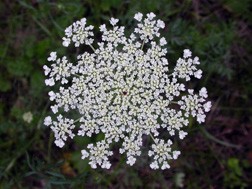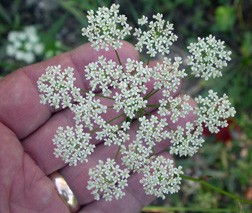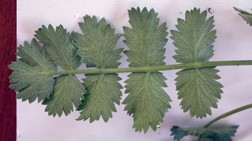The Vitality of Weeds
- Share
- Tweet
- Pin
- Share

A Queen Anne’s Lace umbel has hundreds of tiny, closely packed flowers.
Countless millions of round, white, “welcome” mats dot the countryside of northeastern Wisconsin now, receiving many hungry visitors. The mats are flowers of Queen Anne’s Lace plants, and the hungry guests are scores of butterflies, wasps, bees, beetles, flies and even a few species of bugs.
Our garden is producing a fair amount of vegetables along with the usual large crop of weeds including Queen Anne’s Lace, Pigweed, Lamb’s Quarters, Purslane, and the ever-present Quack Grass and Panic Grass. If only we’d take the time to experiment, at one time in history Lamb’s Quarters was nicknamed “All Good” and was found to contain more iron and protein than either raw cabbage or spinach, and more B1 and calcium than raw cabbage. Many years ago it was considered to be the most valued vegetable in man’s diet.
One of the Queen Anne’s Lace plants stands higher than I am, over five and a half feet. This plant belongs to the enormous parsley or Umbelliferae family (um-bel-LIF-er-ee). The name comes from the Latin word umbella (no “r”), meaning sunshade. A floral cluster such as the Queen Anne’s Lace, referred to as an umbel, is one in which all the stalks arise from one point.
Generally these flower clusters are flat-topped at one stage of their development. Usually a flower head starts out being rounded, next develops into its flat head, and finally becomes somewhat cup-shaped in its final stages. Examine one of these flat-topped umbels from the side and also from below in order to fully appreciate its great beauty.

The more widely spaced, smaller florets of Burnet Saxifrage.
The Burnet Saxifrage closely resembles Queen Anne’s Lace. The highly invasive roadside and fallow-field weed absolutely dominates some parts of northern Door County. It was at least 25 years ago that Charlotte and I noticed the plant along County Highway Z and were able to identify it. To be on the safe side, we sent a complete specimen to Neil Luebke, curator of the herbarium at the Milwaukee Public Museum. Neil quickly reported that they had no record in their herbarium of Burnet Saxifrage having ever existed in Wisconsin. Believe me, this highly efficient plant is on the rapid move!
Burnet Saxifrage, Pimpinella saxifriga (pim-pi-NEL-la sax-IF-ri-ga), also a member of the parsley family, may grow to two or three feet in height and does have parsley-like basal leaves compared to the fine carrot plant leaves of the “Queen.” Whether the plant originally came from the British Isles or southern Europe makes no difference, it’s here to stay!
Another extremely bad weed is virtually carpeting the limy, gravely ditches and fallow fields of this region now, adding a delicate lavender hue to the landscape. It’s the Spotted Knapweed, one of the wild Bachelor Buttons.
Other than the fact that honeybees are strongly attracted to the plant, there is not much good to say about it. This incredibly tough, wiry, prolific invasive favors limy soil and is marching its way westward where it threatens to compete strongly with the natural foods of, for example, elk and beef cattle.
Scientific study tells us that, should the watery juice of this plant enter your blood stream via a cut or bruise it can cause cancer. The warning is out: wear sturdy gloves, trousers and long sleeves whenever pulling this persistent beast from your property.

Burnet Saxifrage leaves resemble parsley leaves.
Bad as many are, I must admit that the more I photograph and study weeds the more impressed I am by their great beauty and variety. The nice aspect of using these tenacious plants as photographic subjects is that they are so successful you can admire them one minute and pull them up the next without worrying about their ultimate disappearance.
Many people describe weeds simply as any plant growing where it is not wanted, or a plant not intentionally sown whose objectionable properties outweigh its good features. Weeds are sometimes even thought of as a punishment for people in return for all the bad things they have done to our planet. One person stated that weeds are simply wildflowers whose virtues have never been discovered.
Good or bad, weeds are bound to enter your life at one time or another. Consider, for example, the prices you pay for food that obviously includes the high cost of weed control where that food is grown. Weeds are highly successful plants in many ways. Most show great adaptability to both diverse and adverse growing conditions. Give some of the seeds a tiny crack in a sidewalk and you’ll soon have another plant or even a dozen.
They are highly efficient seed producers. One large Pigweed was found to have slightly more than 934,000 seeds! The seeds of a Mullein plant can lie dormant for abound 35 years and still be viable.
Many weeds’ seed dispersal is truly astounding. They can float, be carried by the wind, cling to the wet feathers or muddy feet of a duck, be spread via bird droppings, or be transferred for great distances by the mud stuck in the treads of your hiking shoes, a bicycle wheel, or vehicle tires.

Spotted Knapweed, with its colorful, lavender blossoms, is taking over limy, gravely ditches and fallow fields.
Too often people look at all weeds as those successful plants with super-vitality that nobody wants. Their only concern is how to control them. But bear in mind that many weeds serve useful functions, such as checking soil erosion, nursing other new plants, feeding honeybees, adding to the organic material in soil, slowing down the winds, and providing birds and other wild animals with food.
The great majority of weeds respond exceedingly well to three conditions: full sunlight, disturbed soil and a lack of competition from other plants. Provide these three conditions, and you’re bound to have more weeds than you want. Roadside shoulders and ditches rank among the more ideal environments for a host of weeds, largely due to their being constantly disturbed by snowplows and roadside mowers.
I grit my teeth and bear in mind that it’s time to head for the garden and do my good deed for the day – pull Purslane, one of my least favorite weeds on Earth, in spite of their being nutritious to eat. I’m reminded of a Mother Goose nursery rhyme, “A man of words and not of deeds is like a garden full of weeds!”

